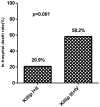Influence of heart failure on the prognosis of patients with acute myocardial infarction in southwestern China
- PMID: 27284294
- PMCID: PMC4887864
- DOI: 10.3892/etm.2016.3211
Influence of heart failure on the prognosis of patients with acute myocardial infarction in southwestern China
Abstract
The impact of heart failure (HF) on acute myocardial infarction (AMI) in patients from southwestern China remains unclear. The present study aimed to compare in-hospital cardiovascular events, mortality and clinical therapies in AMI patients with or without HF in southwestern China. In total, 591 patients with AMI hospitalized between February 2009 and December 2012 were examined; those with a history of HF were excluded. The patients were divided into four groups according to AMI type (ST-elevated or non-ST-elevated AMI) and the presence of HF during hospitalization. Clinical characteristics, in-hospital cardiovascular events, mortality, coronary angiography and treatment were compared. Clinical therapies, specifically evidence-based drug use were analyzed in patients with HF during hospitalization, including angiotensin converting enzyme inhibitors (ACEIs) and β-blockers (BBs). AMI patients with HF had a higher frequency of co-morbidities, lower left ventricular ejection fraction, longer length of hospital stay and a greater risk of in-hospital mortality compared with AMI patients without HF. AMI patients with HF were less likely to be examined by cardiac angiography or treated with reperfusion therapy or recommended medications. AMI patients with HF co-treated with ACEIs and BBs had a significantly higher survival rate (94.4 vs. 67.5%; P<0.001) compared with untreated patients or patients treated with either ACEIs or BBs alone. Logistic regression analysis revealed that HF and cardiogenic shock in patients with AMI were the strongest predictors of in-hospital mortality. AMI patients with HF were at a higher risk of adverse outcomes. Cardiac angiography and timely standard recommended medications were associated with improved clinical outcomes.
Keywords: acute myocardial infarction; heart failure; in-hospital cardiovascular events; in-hospital mortality.
Figures




References
-
- http://www.who.int/mediacentre/factsheets/fs317/en/index.html. [Mar 19;2016 ];World Health Organization: Cardiovascular diseases: Fact sheet 317. Accessed.
-
- Xu T, Li W, Teo K, Wang XY, Liu LS, Yusuf S. INTER-HEART China Investigators: Association of psychological risk factors and acute myocardial infarction in China: The INTER-HEART China study. Chin Med J (Engl) 2011;124:2083–2088. - PubMed
LinkOut - more resources
Full Text Sources
Other Literature Sources
Research Materials
Miscellaneous
